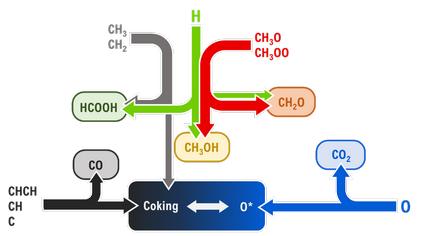Summary
Project
Context and overall objectives
 To catalyse the transformation to a more sustainable and innovative society requires the development of innovative technologies in chemical and energy transformation/utilization areas which use directly renewable energy to substitute the use of fossil fuels. To implement this vision, it is necessary to develop novel technologies for the production of chemicals, fuels and chemical energy storage vectors that allow overcoming the current limitations in the production of renewable energy.
To catalyse the transformation to a more sustainable and innovative society requires the development of innovative technologies in chemical and energy transformation/utilization areas which use directly renewable energy to substitute the use of fossil fuels. To implement this vision, it is necessary to develop novel technologies for the production of chemicals, fuels and chemical energy storage vectors that allow overcoming the current limitations in the production of renewable energy.The ambition of the SCOPE proposal is to develop the scientific bases for a ground-breaking approach (based on catalysis-plasma symbiosis) for direct chemical syntheses using the renewable energy of large-volume key chemicals or energy vectors. Although the core of the project is plasma-catalysis, we include also some comparative analysis of photo- and electro-catalysis to have a better understanding of how to design effective "reactive" catalysts, because several aspects common to these three approaches, as outlined above. We have thus the ambitious aim to put the scientific bases for this new catalytic chemistry which is at the core of the energy and chemistry transition.
We have three target reactions:
(i) N2 fixation: a key reaction for the production of ammonia (NH3) and NOx-made fertilizers;
(ii) CH4 valorization to produce longer C-chain hydrocarbons;
(iii) CO2 conversion to liquid solar fuels.

Work performed
SCOPE project started in April 2019 and is now at the end of its third year of the project. Still, the ongoing Covid-19 pandemic situation caused strong delays in all PI labs and the cancellation of the planned mobility and meeting activities.The general project organization is the following:
- at UniME (cPI) are developed the novel catalysts/electrodes, as well as comparative testing with also photo- and electro-catalytic conversion, besides the development of novel reactor concepts for plasma-catalysis,
- at UANT (PI1) is studied the physicochemical modelling of plasma-catalysis systems, and made experiments on different modalities of plasma generation and interaction with the catalyst
- at UNIWAR (PI2, I3), and associated TUe and UoA, is investigated the reactor optimization and simulation, including the development of a novel approach for spatio-temporal characterization of concentration profiles in plasma-catalysis, and the sustainability-driven assessment of the processes, including distributed manufacturing scenarios, diverse credit accounting for co-valorisation, and supply chain/circularity innovation
The synergy of the PIs competencies is thus realized over the entire dimensional-scale level, from nano-scale (at catalysis level), to micro-scale (at the modelling level), to milli-scale (reactor design) and to mega-scale (plant and technology design).
The project is organized into six work packages (WPs), of which the first WP (WP1: Identify the mechanisms of controlling the selectivity) and in part WP3 (Fast-modulated operations in the presence of plasma), WP4 (Advanced processes for direct conversion of target small molecules) and WP5 (Intensified process-sustainability opportunities) were active in the first three years, in addition to WP6 (Coordination and Dissemination).
The scientific work performed during the first three years of the project was in line with the planned activities described above. Main activities were in WP1, with initial activities in WP2 and WP3, while part of the activities planned in WP4 and WP5 were anticipated. 52 publications were realized within the project in the first three years (all with an indication of project support and green/gold open access), and many additional publications were on closely related aspects. Over 60 dissemination/communication/ outreach/training activities have been made, notwithstanding pandemic limitations.Important actions regarding the implementation of synergy is the realization of two joint international Doctorates:
- the first is the Doctorate ACCESS (Advanced Catalytic Processes for using Renewable Energy Sources), accredited as an International and Intersectoral (industrial) Innovative Doctorate Course from the Italian Ministry of University and Research, and stemming directly from the ERC Synergy SCOPE. The Consortium involves UniME, UANT and TUe, and the company NEXTCHEM, while UNIWAR and UoA PIs participate in the Doctorate Board. The procedure necessary to start the Doctorate made it possible to start it only from 1st November 2020. Some PhD students started a secondment period in other labs of the Consortium.
- the second is a joint Doctorate between UniWAR and UoA for PhD students in co-tutelle

In
total 52 publications were loaded in the portal (sum of RP1 and RP2), with
various joint publications, in addition to an intense dissemination activity.
In total 40 scientists were indicated in the workflow statistic as being
involved in SCOPE activities (at different levels), 35% of which were female.
Progress beyond the state of the art
The following progress beyond the state of the art can be mentioned:
CPI/UniME:- A new type of plasma-catalytic reactor is under development, based on confined generation of nanoplasma within a semiconductor TiO2 nanomembrane, to couple nanoconfined plasma with light illumination.
- A new reactor concept of gas-phase photocatalytic conversion of CO2 based on TiO2 nanomembrane.
- Development of novel improve materials for the challenging reaction of N2 conversion to NH3 in electrocatalytic conditions (NRR), used as benchmarking. This understanding will be the basis to understand better plasma catalysis.
- Development and optimization of TiO2-based nanostructured catalytic electrodes decorated with nanoparticles, for a DBD plasma-catalytic reactors
- Benchmarking with tests on the photo-, electro- or photoelectron-reduction of CO2 and analysis of N2 to NH3 electrocatalytic conversion,
- Framework analysis of the role of direct electrification technologies (plasma-, photo- and electro-catalysis) in the future sustainable and low-carbon energy and chemical production.
PI1/UANT:
- Tthe role of microdischarges and their afterglows,
- An evolution of an isolated pulsed plasma in a vortex flow stabilized microwave
- Design of gliding arc plasma reactors
- Development of a microkinetic model to reveal the effects of plasma-generated radicals, intermediates, and vibrationally excited species
- A microkinetic model to examine the potential of plasma-catalytic partial oxidation (POX) of CH4
- Experiments for NOx production from air, and various N2/O2 mixtures, in a rotating gliding arc,
- Model development for plasma inside cavities
- Modelling fast modulation activities were started.

PI2/UNIWAR, TUe and I3/UNIWAR, UoA:
- A surface microkinetic plasma model for non-oxidative coupling of methane over a Cu catalytic film,
- Synthesis of plasmonic gold nanoparticle,
- Ammonia synthesis with a microplasma jet reactor using N2, H2 and Ar gas mixtures,
- Developing N-doped carbon quantum prepared by a nonthermal microplasma jet,
- Coating by ferroelectric thin films on the inner surface of a quartz tube to strengthen the electric field in the plasma zone and improve the catalytic activity, (
- Developing a dynamic model of a single isothermal CSTR catalytic reactor for formic acid decomposition over TiO2 thin films,
- Determination of temporal 2D concentration profiles of C2H4 and C2H6,
- Development of a 3D-printed proprietary reactor design to place (industrial) catalyst samples on a microporous sieve, to investigate plasma catalysis in the sense of a spatial and temporal co-location of plasma generation and catalytic elemental processes.
- A life cycle assessment with multi-objective optimization to address the economic potential of distributed ammonia fertiliser plants